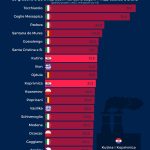As Poslovni Dnevnik/Suzana Varosanec writes, the Republic of Croatia will soon receive the first planning document related to the development of all forms of bicycle traffic, the adoption of which is a prerequisite for the quality and comprehensive development of this type of traffic in the future, according to the Ministry of Maritine Affairs, Transport and Infrastructure.
Minister Oleg Butkovic is drafting the National Plan for the Development of Bicycle Traffic for the period from 2022 to 2027, which plans a number of measures, including those for improving infrastructure, increasing cyclist safety, developing cycling tourism and encouraging the use of bicycles in everyday travel.
The goal of the for the Croatian bike traffic development plan is the development and encouragement of cycling as one of the preconditions for the development of a low-carbon economy, sustainable tourism, the improvement of the spatial planning system, and ultimately healthier, more active and better lives of all people.
For the Croatian bike market, which is growing by about 15% per year, this will be a significant development impulse. According to the average price of a bicycle, it is estimated that the market is currently worth around 30 million euros.
For now, the physical growth of the market isn’t expected in the coming years, but the growth of value, mostly due to the growing share of electric bikes, most certainly is. In a similar volume market, for example, neighbouring Slovenia has a value of approximately 60 million euros.
Here in the Republic of Croatia, the share of electric bikes accounts for about 10% of total bike sales, so there’s great potential, because the EU average is about 30-40 percent, and in the most advanced member states over 50%, even in terms of number of bikes actually sold, not only in terms of the share.
However, these market estimates don’t include new business opportunities based on development inputs prepared by the state through national action measures. The drafting of a strategic document and an Action Plan with 10 defined measures is now in its final phase, while in the coming period, it will be necessary to coordinate the sources of financing individual measures with the competent ministries.
This will be followed by a consultation with interested members of the general public and the adoption of the final document. In addition, rising fuel prices are stimulating the growth of urban cycling, which will only further promote the Croatian bike traffic development plan as a whole.
Particularly innovative solutions are those offered by the City of Varazdin, the first Croatian member of the network of cities and regions of the European Cycling Federation. In Croatian terms, Varazdin is the leader in the solution in this sphere, which, they claim, they will gladly share with others.
“Croatia will quickly catch up with developed countries where cycling has become an urban theme for decades,” they stated from the Office of Varazdin’s mayor, Neven Bosilj.
As the preparation of the Croatian bike traffic development plan is now very much underway, Varazdin expects that this will create the preconditions for the country to catch up with the rest of Europe and unlock the raising of cash from EU funds in order to strengthen the country’s overall cycling infrastructure. In addition to encouraging the service and purchase of new bikes with budget funds for years, Varazdin also plans to build new cycling trails.
In addition to all of the above, there are also some other innovative methods involved, as Varazdin is initiating the procedure for obtaining the ”Employer – Friend of Cyclists” certificate. The certification process is carried out by the very active Cyclists’ Union. Under the title “Bike to work”, Varazdin proposes the creation of a legal basis that would enable employers to financially motivate employees to come to work by bike, following the shining example of more developed European countries.
The City of Varazdin, as a local government unit, has shown its readiness to co-finance bike transport to work for the employees of the city administration, and later for all budget users, but they point out that there are no legal possibilities for that yet.
Among the planned measures in the Croatian bike traffic development plan is the inclusion of Varazdin in various European Union projects. The City Walk project has recently been completed, and the start of the new Erasmus plus project “Booster Cities” is also expected soon, in which one of the topics is the development of cycling and cycling infrastructure.
For more, make sure to check out our dedicated lifestyle section.








